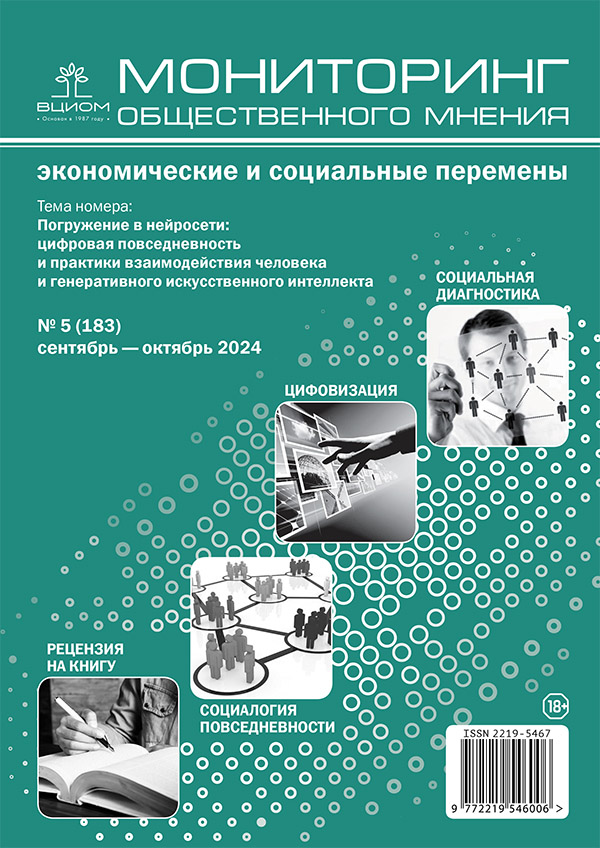Generative Artificial Intelligence in Russian Orthodox Communities: Perception and Practices of Using
DOI:
https://doi.org/10.14515/monitoring.2024.5.2600Keywords:
generative AI, neural network, social construction of technologies, Russian Orthodox Church, Old Believers, religious understanding of technologyAbstract
The article examines the perception and practices of using generative artificial intelligence in religious communities in Russia within the theoretical framework of the social construction of technology (SCOT). The study’s main objective is to identify the interpretive flexibility of generative AI as a technological artifact in different Orthodox communities in Russia (followers of the Russian Orthodox Church and Old Believers of different denominations). The authors assume that the set of contexts and application areas in which generative AI is visible and understandable is relatively narrow soon after the mass release of generative AI (for example, ChatGPT, Midjourney, and other tools). Moreover, given the newness of the technologies and the low likelihood of previous experience with their usage, the authors assume that the early years of interaction with generative AI can be characterized by high flexibility in the interpretations of the artifact. To identify a set of practices and contexts that make generative AI visible for Orthodox communities, an analysis of the channels and platforms of these communities in social and mass media is carried out. It allows us to discuss technology construction by the communities and the general information field. The chronological scope of the study covers the period from January 1 to December 31, 2023. We used the Medialogy database (social media search tool) to avoid sample bias when manually selecting material for work.
Our data analysis reveals that the majority of discussions within Orthodox communities in Russia are focused on establishing the boundaries of the application of generative artificial intelligence and identifying associated dangers. Despite these concerns, the utilitarian use of AI remains unaffected, with the boundary of the permissible use outlined in the sphere of religious meanings. The set of practices for using generative artificial intelligence is currently quite narrow, with the most common practice being the generation or processing of images.
Acknowledgements. N. Dushakova prepared the article as a part of the RANEPA state assignment research programme.
References
Абрамов А. А. Религиозно-этические проблемы искусственного интеллекта: экспертные оценки и позиция Ватикана // Концепт: философия, религия, культура. 2020. Т. 4. № 4. С. 68—82. https://doi.org/10.24833/2541-8831-2020-4-16-68-82.
Abramov A. A. (2020) Religious and Ethical Issues of Artificial Intelligence: Expert Assessments and the Vatican Position. Concept: Philosophy, Religion, Culture. Vol. 4. No. 4. P. 68—82. https://doi.org/10.24833/2541-8831-2020-4-16-68-82. (In Russ.)
Душакова И. С., Владимиров Е. Д. Сети акторов и контроль над информацией: как РПЦ взаимодействует со светским медийным пространством // Stratum Plus. 2022. № 6. С. 427—438. https://doi.org/10.55086/sp226427438.
Dusacova I. S., Vladimirov E. D. (2022) Networks of Actors and Control over Information: How Russian Orthodox Church Interacts with Secular Media. Stratum Plus. Vol. 6. P. 427—438. https://doi.org/10.55086/sp226427438. (In Russ.)
Хьярвард С. Три формы медиатизированной религии: изменение облика религии в публичном пространстве // Государство, религия, церковь в России и за рубежом. 2020. Т. 38. № 2. С. 41—75.
Hjarvard S. (2020) Three Forms of Mediatized Religion: Changing the Public Face of Religion. State, Religion and Church in Russia and Worldwide. Vol. 38. No. 2. P. 41—75. (In Russ.)
Bijker W. E. (2009) Social Construction of Technology. In: Friis J. K. B. O., Pedersen S. A., Hendricks V. F. (eds.) A Companion to the Philosophy of Technology. Oxford: Wiley-Blackwell. P. 88—94. https://doi.org/10.1002/9781444310795.ch15.
Campbell H. (ed.) (2012) Digital Religion: Understanding Religious Practice in New Media Worlds. London: Routledge.
Campbell H. A., Cheong P. H. (2023) Introduction. In: Campbell H. A., Cheong P. H. (eds.) (2023) Thinking Tools on AI, Religion & Culture. College Station, TX: Digital Religion Publications. P. 7—8.
Campbell H. A., Cheong P. H. (eds.) (2023) Thinking Tools on AI, Religion & Culture. College Station, TX: Digital Religion Publications.
Campbell H. A., Evolvi G. (2019) Contextualizing current digital religion research on emerging technologies. Human Behavior & Emerging Technologies. No. 2. P. 5—17. https://doi.org/10.1002/hbe2.149.
Ekbia H. (2010) Fifty Years of Research in Artificial Intelligence. Annual Review of Information Science and Technology. Vol. 44. P. 201—242. https://doi.org/10.1002/aris.2010.1440440112
Elliott A. (2022) The Complex Systems of AI: Recent Trajectories of Social Theory. In: Elliott A. (ed.) The Routledge Social Science Handbook of AI. New York, NY: Routledge. P. 3—16.
Falahatpisheh Z., Khajeheian D. (2020) Affordances and IT Design: A Typology for Social Media and Platform Affordances. 13th CMI Conference on Cybersecurity and Privacy (CMI) — Digital Transformation — Potentials and Challenges (51275), Copenhagen, Denmark. P. 1—7. https://doi.org/10.1109/CMI51275.2020.9322681
Jacoba R. C. (2023) Exploring the Role of Artificial Intelligence in Interreligious Discourse. Religion and Social Communication. Vol. 21. No. 2. P. 375—400. https://doi.org/10.62461/RCJ100323
Pinch T. J., Bijker W.E. (1984) The Social Construction of Facts and Artefacts: Or How the Sociology of Science and the Sociology of Technology Might Benefit Each Other. Social Studies of Science. Vol. 14. No. 3. P. 399—441. https://doi.org/10.1177/030631284014003004
Rahman F. A., Mohammed R. R. AI in the Middle East: Balancing Cultural Identity, Gender Dynamics, and Religious Perspectives. In: Campbell H. A., Cheong P. H. (eds.) Thinking Tools on AI, Religion & Culture. College Station, TX: Digital Religion Publications. P. 17—20.
Singler B. (2023) How I Stopped Worrying and Learned to Question the Apocalyptic AI. In: Campbell H. A., Cheong P. H. (eds.) Thinking Tools on AI, Religion & Culture. College Station, TX: Digital Religion Publications. P. 10—11.
Downloads
Published
How to Cite
Issue
Section
License
Copyright (c) 2024 Monitoring of Public Opinion: Economic and Social Changes

This work is licensed under a Creative Commons Attribution-NonCommercial-ShareAlike 4.0 International License.






